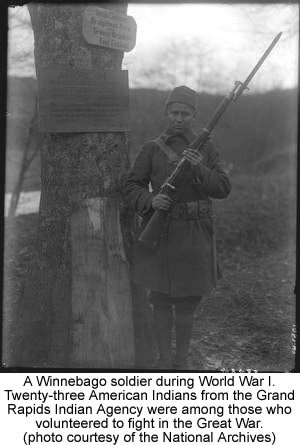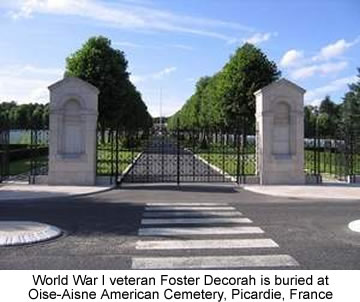 |
Canku Ota
|
 |
|
(Many Paths)
|
||
|
An Online Newsletter
Celebrating Native America
|
||
|
July 2014 - Volume 12
Number 7
|
||
|
|
||
|
Native American WWI
Volunteers Not Forgotten: River City Memoirs
|
||
|
by Dave Engel - Wausau
Daily Herald
|
||
|
Shortly after the U.S. declared war on Germany in April 1917, Wisconsin Winnebagos (Ho Chunk) joined the 32nd "Red Arrow" Infantry Division at Camp Douglas, although they were exempt from selective service. In July 1917, the Rapids Ah-dah-wa-gam chapter of the Daughters of the American Revolution sent each of 23 new soldiers from the Grand Rapids Indian Agency district khaki "comfort bags" containing useful personal items. "All of us Indians were in thanks to get the good things you have sent," wrote recruit James Brown. "We drill at 7:30 in the morning to 10:30 and in the afternoon we only drill one hour and if we have any ball games we don't drill in the afternoon. We are having all kinds of fun. "There are about 154 boys in our Co. There are about 15 Indian boys and the rest are white. "We got a YMCA here and also a show tent where we see a show every night. We all can drill just as good as any body in the company now."
The Ah-da-wa-gam chapter provided a Service Flag to the Indian Agency here in December 1918, honoring three of the same Winnebagos who had received comfort bags and who had died or been killed. On June 12, 1919, two more gold stars signified two more deaths. Patriotism and good soldiering, said the accompanying statement, "place them in the front ranks of the American Expeditionary forces." Of the 23 at Camp Douglas, these five had died:
Foster Decorah was a character of note. A minor fur trader and "sharpshooter of renown," in 1907 the elder Decorah had killed ten wolves and collected $100 bounty. At a "condition of Indian affairs hearings" in 1911, he told Wisconsin Senator and later presidential candidate Robert M. La Follette he once had worked in a flour mill for $1 a day but soon quit. Then of Reedsburg, Decorah, father of two boys and a girl, said he ran an Indian camp, shooting gallery and sold beads as concessions in Illinois "picnic parks." Liquor trouble brought Decorah into contact with federal judge Kenesaw Mountain Landis, later to become the first U.S. Commissioner of Baseball. In one of their several meetings, Landis suggested, "Let's you and I go on the water wagon for the rest of this term of court." Decorah also appeared in the Landis court in 1914 when a bar owner in La Crosse sold him beer after he claimed to be Mexican. He had been acting as a government decoy.
A fellow member of the 32nd Division said that Decorah and his nephew Robert Decorah had fallen on the same field and that Decorah's son was also a member of the company. "I had often watched the older go through bayonet practice. We taught our men to assume a ferocious expression in bayonet conflict and Foster Decorah's face was worth study at such times." Foster Decorah is buried at Oise-Aisne American Cemetery, Picardie, France. His son, Henry, died in 1993, at age 94, and is buried at Ft. Snelling National Cemetery, Minneapolis, Minn. Dave Engel is a local historian and author of books in the "River City Memoirs" series. His columns are featured monthly in Daily Tribune Media. |
|
|
||
|
|
||
| Canku Ota is a free Newsletter celebrating Native America, its traditions and accomplishments . We do not provide subscriber or visitor names to anyone. Some articles presented in Canku Ota may contain copyright material. We have received appropriate permissions for republishing any articles. Material appearing here is distributed without profit or monetary gain to those who have expressed an interest. This is in accordance with Title 17 U.S.C. Section 107. | ||
|
Canku Ota is a copyright ©
2000 - 2014 of Vicki Williams Barry and Paul Barry.
|
||
 |
 |
|
|
The "Canku
Ota - A Newsletter Celebrating Native America" web site and
its design is the
|
||
|
Copyright ©
1999 - 2014 of Paul C. Barry.
|
||
|
All Rights Reserved.
|
||
 They
risked their lives fighting for a country that hadn't yet granted
them citizenship.
They
risked their lives fighting for a country that hadn't yet granted
them citizenship. As
the troops embarked for France, a story published in 1975 relates,
a government official stood at the foot of the gangplank to inform
American Indians they did not have to serve or go overseas. The
Winnebago leader turned and said, in his language, "Does any one
of you wear a skirt? If so, go home."
As
the troops embarked for France, a story published in 1975 relates,
a government official stood at the foot of the gangplank to inform
American Indians they did not have to serve or go overseas. The
Winnebago leader turned and said, in his language, "Does any one
of you wear a skirt? If so, go home." A
descendent of the "illustrious Chief Decorah," he presented a commanding
figure when he appeared as a witness in another case, "wearing the
khaki of a soldier with broad shoulders and graceful carriage."
A
descendent of the "illustrious Chief Decorah," he presented a commanding
figure when he appeared as a witness in another case, "wearing the
khaki of a soldier with broad shoulders and graceful carriage."